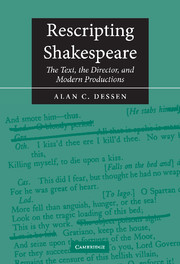Book contents
- Frontmatter
- Contents
- Acknowledgments
- Note on documentation
- List of abbreviations
- 1 “Let it be hid”: price tags, trade-offs, and economies
- 2 Rescripting Shakespeare's contemporaries
- 3 Adjustments and improvements
- 4 Inserting an intermission/interval
- 5 What's in an ending? Rescripting final scenes
- 6 Rescripting stage directions and actions
- 7 Compressing Henry VI
- 8 The tamings of the shrews: rescripting the First Folio
- 9 The editor as rescripter
- Conclusion: what's not here
- Appendix: productions cited
- Notes
- Index
9 - The editor as rescripter
Published online by Cambridge University Press: 22 September 2009
- Frontmatter
- Contents
- Acknowledgments
- Note on documentation
- List of abbreviations
- 1 “Let it be hid”: price tags, trade-offs, and economies
- 2 Rescripting Shakespeare's contemporaries
- 3 Adjustments and improvements
- 4 Inserting an intermission/interval
- 5 What's in an ending? Rescripting final scenes
- 6 Rescripting stage directions and actions
- 7 Compressing Henry VI
- 8 The tamings of the shrews: rescripting the First Folio
- 9 The editor as rescripter
- Conclusion: what's not here
- Appendix: productions cited
- Notes
- Index
Summary
“Here's a change indeed!”
Othello, 4.2.106In the process of rescripting directors often take on the role of editors, whether to reconfigure the horse-courser scene in Doctor Faustus, the Christopher Sly material in The Taming of the Shrew, the final scenes of Othello and Coriolanus, or supernatural elements in Macbeth and The Tempest. Conversely, an editor wrestling with a problematic passage or stage direction may consciously or inadvertently take on the role of a director and make choices according to a sense of how X could be, should be, or would have been staged. As noted in chapter 6, E. A. J. Honigmann has argued in favor of an editor's prerogative to make necessary changes in stage directions in keeping with the “responsibility: to see the plays … as we would wish to direct them ourselves.” Clearly, decisions must be made: that is what editors do and what many readers want. The danger is that in seeking to clarify a situation for a first-time reader that editor may in fact be closing down an equally valid option, especially for a potential user in the theatre.
In the past many editors may have ignored or even scorned the theatrical facets of their work, but more recent practitioners are far more knowledgeable and sympathetic about such matters. Indeed, in the 1980s and 1990s one sub-group of editions exhibits a performance orientation by including accounts of production choices, photographs, stage history, additional stage directions, and other ancillary material to enhance a reader's awareness of a theatrical dimension that extends beyond the printed page.
Information
- Type
- Chapter
- Information
- Rescripting ShakespeareThe Text, the Director, and Modern Productions, pp. 209 - 234Publisher: Cambridge University PressPrint publication year: 2002
